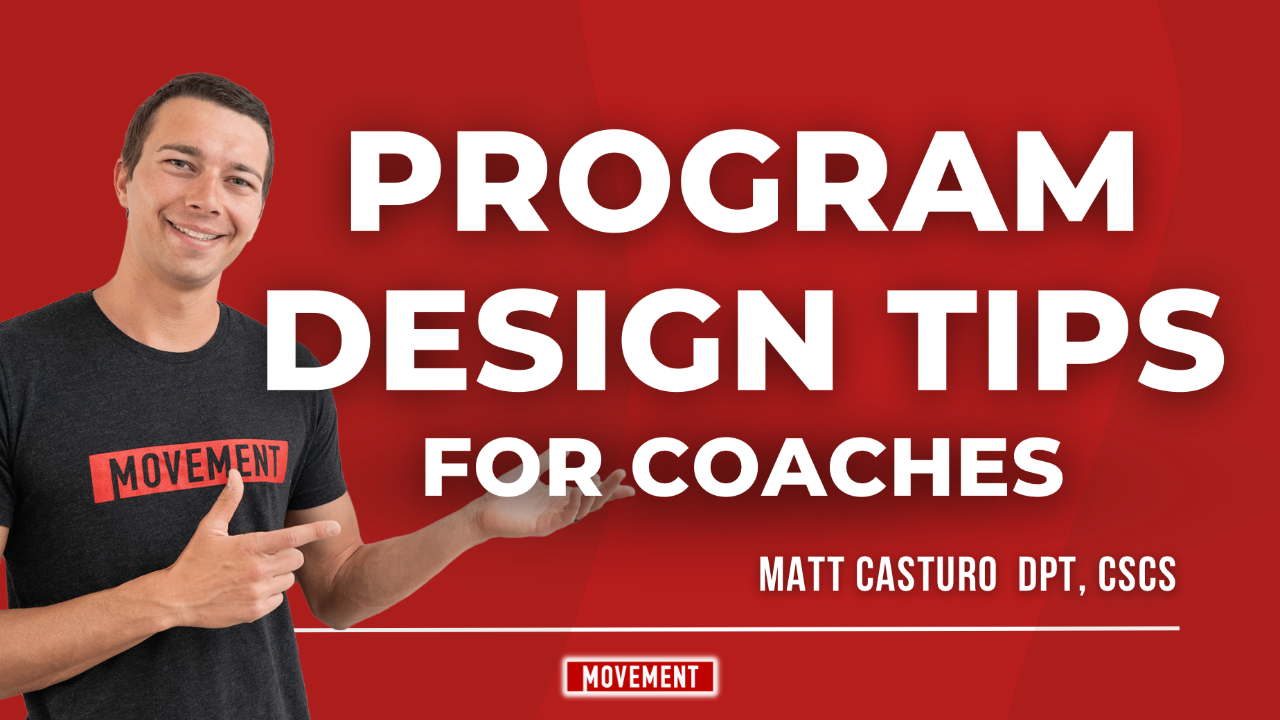Program Design Tips for Coaches
Jul 21, 2023
Edited by: Danielle Abel
Program design might feel overwhelming when you're starting out, or if you're transitioning to working with a new type of client or athlete, but remember, getting started is the best thing you can do.
Everyone starts a bit shaky when it comes to programming exercises for clients & athletes, but in this article, we want to offer 3 of our top tips, that, no matter what you program, will help you to get better at programming.
Track Progress
When it comes to fitness, it can be helpful to decide between you and your client, 1 to 3 different tests that are meaningful to the goals of the program. For lifestyle clients, this might mean simply being consistent with following a structured training program.
- Track how many sessions they complete compared to the goal number of sessions
- Help them to see the progress they've made
- If needed, work with them on overcoming any barriers that preventing them at getting closer to the goal number of sessions they set for themselves
For athletic types or clients with athletic performance goals, you might decide to track a movement in the gym or from the field that is meaningful for them. For example, if you're working with a runner, have a conversation with them and find out what they'd like to see improvements in related to their endurance, speed, etc.
If you're working with someone who values increases in strength, choose a movement or 2 and help them measure their progress over time.
- Decide on the movement, get specific, for example, trap bar deadlift
- Determine their baseline, what are they lifting now and where are they starting from?
- When will you measure their progress? This could be in 4 weeks, 8 weeks,etc.
The goal of measuring and tracking progress is that you will be able to tell if the programming you are providing is helping your clients and athletes make progress. If you notice that progress is not headed in the right direction, try & understand more about whether or not it was an issue with the client or with your programming.
- Were they consistent?
- Did they have questions or concerns that were unaddressed?
- Did you choose movements that were specific to their goals?
- Were there any lifestyle factors that came into play? (ie: lack of sleep, high stress, poor nutrition, etc.)
Listen to Your Clients
This one sounds easy, but it's actually hard to do in real life. As a fitness professional, we're sure you take a great deal of pride in what you do. However, sometimes there are situations where your client told you something that you didn't think was important and you might have ignored it, or sometimes where your client forgot to tell you something that was really important.
Either way, these situations happen. Instead of getting defensive or upset, choose to get curious.
- Ask more questions, try to find out more information, and try to look at the data, instead of playing into how you are feeling.
- You can be an incredibly smart coach, but if your clients don't feel like you care about them or you don't listen to them, you won't have many clients.
It takes more time to listen to clients and adjust your coaching to their needs and requests, but it usually pays dividends in the long run. Keep in mind setting and holding boundaries is important as well, but just try to find a middle ground where your client feels supported and you're able to have professional and personal time.
Be Flexible
You know the most ideal plan to go from point A to point B, but if your clients or athletes aren't on board with your ideas, it will be really hard to help them see progress. A good coach takes what they know, and adapts it to the needs and desires of those they're coaching.
- If a client doesn't want to do cardio, ask them what type of activity they enjoy, and meet them where they're at
- If your client can't commit to 4-5 sessions per week, ask them if they could commit to 2-3
If you notice your client doesn't seem to be making progress in the way they desire, it's perfectly acceptable to have an open, honest, but professional conversation with them about their program, and find out if they would be willing to make some compromises if they felt it would help them to be more successful.
We think you might be surprised at what your clients or athletes would say, when given a change to make some changes that might feel hard.
Just Start
You probably already know what should be included in a workout or training session for your clients or athletes, so just start. Keep in mind, as you gain experience and learn, your programming will improve over time. Try to give yourself grace and realize that all coaches start somewhere.
- Write 1-3 programs to have on hand so you can explain the benefits of your coaching services to clients
Save your client's or athletes' programs somewhere safe so you can refer back to them with you have another client who is similar to past clients. When this happens, make any necessary adjustments or customizations and keep going.
Support & Courses Available
Ready for even more support? Our Program Design 101 Course teaches you exactly how to organize an annual training plan and provides sport-specific examples, and even includes done-for-you programming templates by phase. Click the link here to check it out.
Stay connected with news and updates!
Join our mailing list to receive the latest news and updates from our team.
Don't worry, your information will not be shared.
We hate SPAM. We will never sell your information, for any reason.

